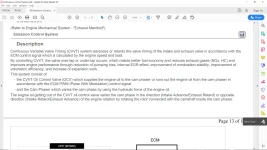Carguy - no matter how respectfully we try and point out that you don't have enough facts to support our concurrence, yet you dig in get bothered. We're not. Take a chill pill.
I believe you overestimate the functionality/capability of the car's ECUs. They operate off of a a series of fixed maps that drive the engine. In the early days of digital processing, they had (as I recall) about 6 different operating modes (cold start, warm start, steady state, idle, full throttle, etc. etc.) where they would use more and more inputs - but still fixed maps (It's been a while since I pulled up my old Bosch fuel injection design book). Today there are probably more modes and many more maps because memory and processors today are robust and much cheaper than before. We've also gotten more sophisticated in the 40 years or so of digital controls on engines.
With regard your claims to what is inferred as processors making infinite adjustments and tweaks... this is a rather broad brush to paint with no specifics. Here's some data however contra the inference. As an example, there's no computer controlling Ford's overhead cam advance and retard - that's done by a hydraulic system (oil pressure actuated phasers - one of the two main styles used today). The movement of the cams is a function of the positive displacement oil pump (which is a function of RPM). It basically (and not with tremendous accuracy) advances and retards of the cams as a function of RPM. It is NOT a function of air flow or throttle position - you get the same advance and retard at 3200 RPM each and every time you're there (albeit with some variation due to the inaccuracy of the oil control). There is no ECU tie reading the MAF and then making adjustments - it's all fixed flow paths of oil and only varies by pump output pressure. I've not reviewed this Genesis engine's cam design, but it may be similar if not the same. Yes, these systems are evolving, but are no where near what I believe you to think of 'infinitely adjustable'. As an oh, by the way - they were not designed as much to optimize power (although they do allow for a broader torque curve), but they were as much driven by OEMs desires to get rid of the problematic EGR systems (oxides of nitrogen in emissions to be more specific). Another oh, by the way - the more recent CTA (cam torque actuated) phasers still are RPM dependent (not ECU controlled) - they have fixed mechanical programs based on their design that are related to - guess what - RPM - not air flow or throttle position.
To other ECU functions - once the ECU maps are burned (call that the OEM tune) - they are not changed nor variable. They are fixed. I believe the only iterations done are in closed loop operation where they tune for O2 content in the exhaust (to infer the proper emission output). Some of the manufacturers do (like Ford I believe) have algorithms such that once you are steady state for a long time at highway conditions, it is tweaking the economy a little bit. I've never seen where any of the manufacturers build in AI type software to constantly rewrite maps in order to tweak peak power output. I'm pretty confident that's just not done!
The point of all this is that changing an air filter will not make a hill of beans difference in how the engine operates the cams, advances timing, or tweaks to optimize. It's going to have the exact same effect as if you drove your car in a 40 degree day vs. a 100 degree day - the colder air (with more oxygen in it BTW) will register a higher MAF flow rate. Your computer will compensate for that likely on the same ECU map by simply squirting just a little more fuel in to compensate. Since you have more oxygen and fuel, voila - you have more power. In the same manner, a lower restriction in your inlet tract (better air filter) allows lower differential pressure, which results in higher flow. Same effect.
Now - to how much more air flow - BlancaGenny said what we've all been saying this entire post - to quote -
'The most accurate way to measure on a dyno is back to back runs. Same day, same place, same dyno, same parameters. But, it is never 100 percent accurate. '.
It is great that you are so fervent about your claims. You're happy. We get it. Enjoy. Just please don't keep trying to convince us without that kind of data (dyno) as to the significance of the improvements you allege. We just don't have as much faith in your butt sensors as you do

.
respectfully submitted










